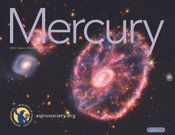2022 Volume 51 Issue No. 2

Table of Contents:
[20] Space News
A rundown of some of the most notable discoveries and need-to-know news in space and time.
[20] Supermassive Success
After five years of data analysis and simulations, astronomers revealed their first image of the monster black hole at the center of our Milky Way Galaxy.
[28] A New View
Last month, the James Webb Space Telescope team showed the world the observatory’s first views of the cosmos.
Departments:
[3] Perspectives, Liz Kruesi
Astronomy’s Success Stories
[4] First Word, Linda Shore
Science Communication in the Age of Misinformation
[6] Annals of Astronomy, Clifford J. Cunningham
The Winter Solstice Lunar Eclipse of 1638
[8] Armchair Astrophysics, Christopher Wanjek
Never Mind the Pulsar. Here Comes the Antimatter!
[10] Education Matters, Brian Kruse
The Importance of Investigating the World Surrounding Us
[12] A Little Learning, Scott T. Miller
Booster Shots
[40] Reflections, Liz Kruesi
Insight’s Energy is Dwindling
************
Supermassive Success (Feature)
By Steve Murray
The Event Horizon Telescope (EHT) collaboration is now two for two. The first image of Sagittarius A*, the supermassive black hole at the heart of our galaxy, was revealed to the public three years after their groundbreaking image of galaxy M87’s black hole. The Earth-size telescope has now given astronomers two laboratories to study supermassive black holes, each with a different story to tell.
A New View (Feature)
By Liz Kruesi
Last month, the James Webb Space Telescope (JWST) team showed the world the observatory’s first views of the cosmos. These stunning images are a culmination of precision engineering, astronomical dreams, and complex software all working together to reveal a new cosmic view filled with discoveries. “I’m so thrilled and so relieved,” said JWST’s Senior Project Scientist John Mather following the release of the first images.
Insight’s Energy is Dwindling (column)
By Liz Kruesi
NASA’s Insight spacecraft is in its final few weeks. This Mars lander is so coated in dust that its power is rapidly dwindling. Insight operates by the power of the Sun, and it has two large solar panels to collect that light. But Mars is dusty, and storm after storm has led to layers of dust collecting on the solar panels.
